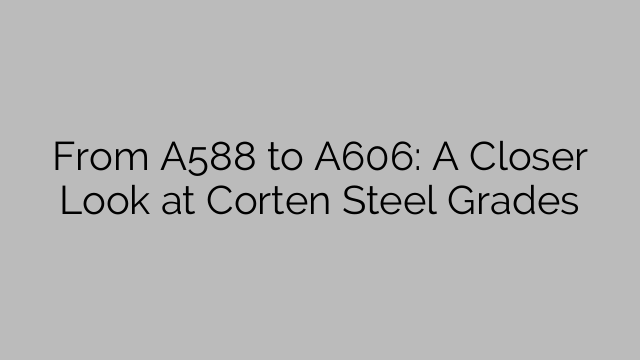Both A588 and A606 are high-strength, low-alloy steels that exhibit atmospheric corrosion resistance. This means they form a protective rust layer when exposed to external elements, which not only gives them their characteristic rusty appearance but also acts as a barrier against further corrosion. However, there are slight differences in their composition and mechanical properties that make them suitable for different uses.
A588, also known as ASTM A588 or A242, is a high-strength, low-alloy steel primarily used in structural applications such as bridges and buildings. It contains copper, chromium, nickel, and phosphorus, which provide enhanced corrosion resistance compared to regular carbon steel. A588 has a minimum yield strength of 50,000 psi (345 MPa) and tensile strength of 70,000 psi (483 MPa), making it ideal for heavy-duty structures exposed to harsh weather conditions. Its high-strength properties make it highly durable and resistant to structural damage.
On the other hand, A606, also known as ASTM A606 Type 4, is a weathering steel that is used in outdoor applications where aesthetics are prioritized. It contains additional alloying elements such as copper, chromium, nickel, and phosphorus, similar to A588. However, A606 is typically used for thin gauge structural and architectural components, such as siding, roofs, and decorative panels. Its lower yield strength of 50,000 psi (345 MPa) and tensile strength of 70,000 psi (483 MPa) make it more malleable and easier to shape, resulting in intricate designs and interesting patterns.
Both A588 and A606 Corten steel grades offer excellent corrosion resistance, making them suitable for outdoor applications without the need for regular maintenance or painting. The development of the protective rust layer not only adds beauty and texture to the material but also acts as a natural barrier against further corrosion, increasing the lifespan of the steel.
When choosing between A588 and A606, it is important to consider the specific application and desired appearance. A588’s higher strength and durability make it suitable for heavy-duty structures, while A606’s malleability and aesthetic appeal make it ideal for architectural designs. Consulting with a structural engineer or architect can help determine the best grade of Corten steel for a particular project.
In conclusion, Corten steel offers a visually striking alternative to traditional construction materials, with its weathered appearance becoming increasingly popular in contemporary architecture. The grades of Corten steel, such as A588 and A606, each have their own distinct properties and applications. Understanding these differences can help architects and designers make informed choices when selecting the appropriate grade for their projects. Whether it’s a bridge, building, or decorative panel, Corten steel can provide both strength and beauty to withstand the test of time and weather.
[ad_2]

